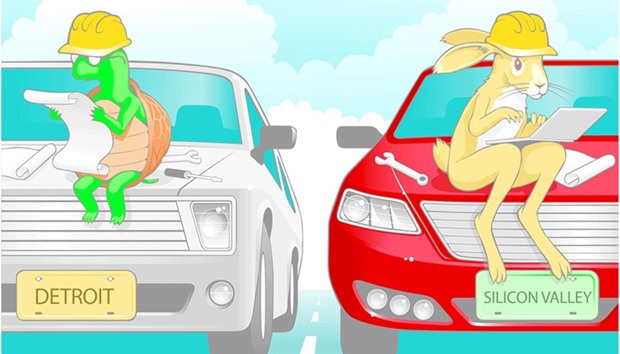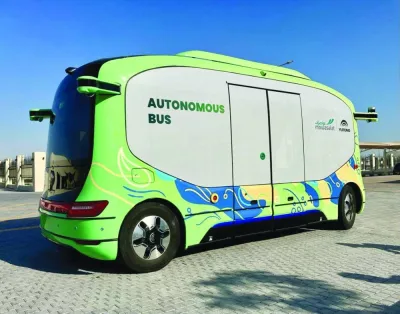The Audi SUV crept through city streets, obeying speed limits, stopping short at signals and keeping neatly between lane markers during morning rush hour. The driver’s hands hovered above the steering wheel.
The real driver was a system of sensors, processors and software made by auto supplier Delphi and tech company Mobileye. The SUV needed few corrections on its pre-programmed 20-minute route through Mountain View on a recent sunny morning.
“This vehicle is very conservative,” said Gary O’Brien, a Delphi engineer in charge of global advanced engineering. “It drives like your grandmother.”
That’s by design.
Tech companies, automakers and suppliers agree on the potential benefits of self-driving cars, but they still diverge on how to make and deploy them. While many in Silicon Valley rush to get autonomous vehicles on the road, traditional automakers are taking a more deliberate approach. Which approach will carry the day is still in question.
“It’s fascinating to watch,” said Karl Brauer, executive publisher of Kelley Blue Book.
The federal government released new guidelines for autonomous vehicles in September, pointing the way for broader adoption of the technology. Major automakers and suppliers have entered the field, joining the swarm of Silicon Valley tech firms seeking software solutions to driving safety.
Some Silicon Valley companies are speeding toward the use of self-driving technology. Uber pushed into the San Francisco streets without permission to operate autonomous vehicles in December. Tesla CEO Elon Musk touts Autopilot as the best driver assist package in the world, despite criticism the technology was introduced too soon. The system was involved in the first, fatal self-driving accident in the US last year, although federal investigators in January cleared Tesla in the crash.
Meanwhile, the traditional auto industry has moved slower. About 20 companies – including most major automakers – have similar or better driver assistance systems than Tesla’s, Brauer said. But they haven’t introduced all the features to their customers, and “they’re not bragging” about them either, he added.
Tech companies and automakers have drawn clear lines on how they believe autonomous driving should work. Google, at the forefront of self-driving car research and development, wants to make a big leap to completely autonomous cars. It’s been conservative for a Silicon Valley company.
On the other hand, Tesla released Autopilot in October 2015 with high expectations. “While truly driverless cars are still a few years away, Tesla Autopilot functions like the systems that airplane pilots use when conditions are clear,” the company said. The package applies brakes to avoid collisions, keeps the vehicle within lane markers and can steer through turns with the flick of a signal. Musk insists that releasing Autopilot, even in an early, imperfect version, makes Teslas safer.
Federal highway investigators found during their probe into the Autopilot crash that Teslas with automatic steering systems were about 40 percent less likely to be involved in collisions.
The company began rolling out an enhanced Autopilot software version last month. New Teslas are equipped with 40 times the computing power of older models, and come with cameras, radar and ultrasonic sensors.
Bruno Fernandez-Ruiz, chief technology officer of Nexar, a start-up that makes a driver-assistance package based on smartphone hardware and an app, said the difference between Silicon Valley and the traditional auto industry is fundamental. “We think software first,” Fernandez-Ruiz said, while the auto industry thinks hardware first.
Bruno and his co-founder started the company in part because they were too impatient to wait years for automakers to roll out safety features.
Tesla’s Autopilot gets an edge over other companies by collecting data on driving patterns and environments – vital information for building and improving autonomous systems. Bruno said auto manufacturers realise the value in driving data collected by start-ups, and Nexar and many other tech firms have private agreements with major manufacturers.
“At the end of the day,” he said, “whoever has data is going to win.”
In contrast, automakers aim to ease their customers into self-driving technology through new, semi-autonomous driver assistance systems. Many of the features are similar to Autopilot but require more driver involvement.
Delphi, an established parts manufacturer, has tested its autonomous system in cross-country trips and exhibits in California, Nevada and Singapore. The suite of sensors, hardware and software was produced by Delphi and Mobileye, a leader in developing vision-based systems for autonomous driving.
Detroit can move slowly by Silicon Valley standards, Glen De Vos, Delphi’s newly appointed chief technology officer acknowledged.
“We really understand how to take a product and make it automotive grade,” he said. “It has to work flawlessly every time.”
Auto and tech cultures have been intertwined for years. Major automakers have established research labs in Silicon Valley, and start-ups and tech giants have partnered with vehicle makers to test ideas and products. Google has teamed up with Fiat Chrysler for its self-driving car effort, while Uber has partnered with Volvo and Lyft with GM.
Traditional auto suppliers like Delphi are learning from the high-tech culture, De Vos said. Delphi has partnered with several tech companies, accelerated its research and is doubling the size of its Silicon Valley operations. Competition to develop and deliver driver assist and autonomous systems stimulates the market, De Vos said. But that development “needs to be done responsibly,” he added. To win the race for autonomous driving, tech companies and automakers will have to work together, Brauer said. “They need each other.” – The Mercury News/TNS



